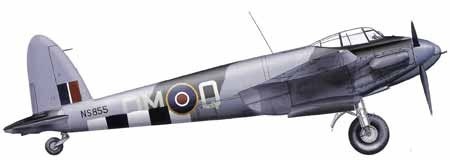
About This Unit

No. 107 Squadron (RAF)
No. 107 Squadron RAF is featured on this site because it was one of many RAF Sqadrons to which RAAF personnel were assigned to in WW2 under the Empire Air Training Scheme. RAAF personnel served, lived and died in a great many squadrons across the wartime RAF, and in other Commonwealth Squadrons under command of the RAF's three principal commands; Fighter Bomber and Coastal Commands and geographic commands farther afield in the Mediterranean and Far East.
No. 107 Squadron RAF saw service in WW1 and post WW2, but for the purposes of the VWMA, this unit story focuses on WW2, when a significant number of RAAF personnel were assigned to it as the end-product of the Empire Air Training Scheme.
No. 107 Squadron's WW2 service in WW2 began on the outbreak of war as a light bomber unit equipped with the Bristol Blenheim twin-engine light bomber. It was one of the few bomber squadrons to begin active operations in 1939, taking part in the attack on Wilhelmshaven on the second day of the war.
The squadron was then involved in the fighting in Norway (April 1940), before taking part in the desperate attacks on German troop columns during the short-lived Battle of France.
The squadron extracted successfully as the fall of France unfolded and then with the threat of invasion imminent, took part in the attack on German barges and preparations along the French and Belgian coastline.
In March 1941 the squadron moved to Scotland, detached under command of Coastal Command, and spent the next two months carrying out anti-submarine patrols and attacks on German shipping in the North Sea, before returning to Bomber Command and to Great Massingham in Norfolk. These were quite hazardous as the squadron lost two COs during these operations, Wing Commander Cameron in April and Wing Commander Birch on 4 May 1941 (2.).
In August 1941 No.107 Squadron was assigned to Malta, which was under attack by the German Luftwaffe and Italian Regia Aeronautica. No.107's role was however offensive, and it attacked Axis targets in Italy, Sicily and North Africa. This lasted until 9 January 1942 when the Axis aerial assault intensified and No.107's losses mounted. Surviving aircraft and crews were withdrawn, and the detachment was dissolved. Losses among the squadron had been heavy – 90% of all original and replacement crews were killed in action during the Malta operations.
In the same month the squadron reformed back at Great Massingham and began to receive Douglas A20 'Havoc' light bombers renamed 'Boston' in British service, and in March operations from Britain resumed. For the next two years the squadron attacked German airfields and transport targets in occupied Europe. It famously took part in the raid on Eindhoven in Holland targeting the Philips radio works,
In February 1944 the Squadron was transferred to the 2nd Tactical Air Force for the impending invasion of Europe. it was re-equipped with the fast and heavily armed de Havilland Mosquito FB.VI, and began to fly night intruder missions over Germany and occupied Europe. This involved individual aircraft flying very low, at night, with orders to 'shoot anything that moved’. Particular targets included rail junctions, transport hubs and known troop concentrations particularly s part of 'Transportation Plan' raids in the run up to D Day. These were designed to impede the capacity of the Nazis to reinforce their forward elements.
In November 1944, the Squadron relocated to Cambrai in northern France and remained there until the end of the war, continuing night intruder operations. After War's end, No. 107 Squadron served as part of the Allied Occupation Force in Germany, before being re-designated as No. 11 Squadron in 1948.
Sources:
1. History of War - http://www.historyofwar.org/air/units/RAF/107_wwII.html (www.historyofwar.org)
2. Wikipedia - https://en.wikipedia.org/wiki/No._107_Squadron_RAF (en.wikipedia.org)












